NCERT Solutions Class 10 Maths
Chapter – 2 (Polynomials)
The NCERT Solutions in English Language for Class 10 Mathematics Chapter – 2 Polynomials Exercise 2.3 has been provided here to help the students in solving the questions from this exercise.
Chapter : 2 Polynomials
- NCERT Class 10 Maths Solution Ex – 2.1
- NCERT Class 10 Maths Solution Ex – 2.2
- NCERT Class 10 Maths Solution Ex – 2.4
Exercise – 2.3
1. Divide the polynomial p(x) by the polynomial g(x) and find the quotient and remainder in each of the following:
(i) p(x) = x3 – 3x2 + 5x – 3, g(x) = x2 – 2
(ii) p(x) = x4 – 3x2 + 4x + 5, g(x) = x2 + 1 – x
(iii) p(x) =x4 – 5x + 6, g(x) = 2 – x2
Solution –
(i) p(x) = x3 – 3x2 + 5x – 3, g(x) = x2 – 2
Given,
Dividend = p(x) = x3 – 3x2 + 5x – 3
Divisor = g(x) = x2 – 2
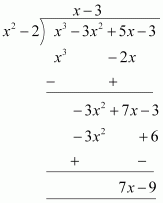
Quotient = x – 3
Remainder = 7x – 9
(ii) p(x) = x4 – 3x2 + 4x + 5, g(x) = x2 + 1 – x
Dividend = p(x) = x4 – 3x2 + 4x +5
Divisor = g(x) = x2 + 1 – x
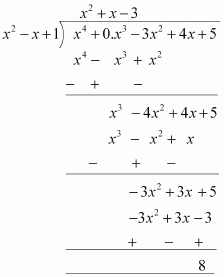
Quotient = x2 + x–3
Remainder = 8
(iii) p(x) =x4 – 5x + 6, g(x) = 2 – x2
Dividend = p(x) =x4 – 5x + 6 = x4 + 0x2 – 5x + 6
Divisor = g(x) = 2 – x2 = – x2 + 2
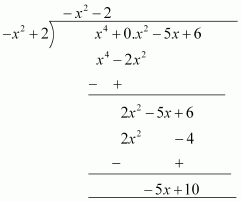
Quotient = -x2 – 2
Remainder = – 5x + 10
2. Check whether the first polynomial is a factor of the second polynomial by dividing the second polynomial by the first polynomial:
(i) t2 – 3, 2t4 + 3t3 – 2t2 – 9t – 12
(ii) x2 + 3x + 1 , 3x4 + 5x3 – 7x2 + 2x + 2
(iii) x3 – 3x + 1, x5 – 4x3 + x2 + 3x + 1
Solutions –
(i) t2 – 3, 2t4 + 3t3 – 2t2 – 9t – 12
First polynomial = t2 – 3
Second polynomial = 2t4 + 3t3 – 2t2 – 9t – 12
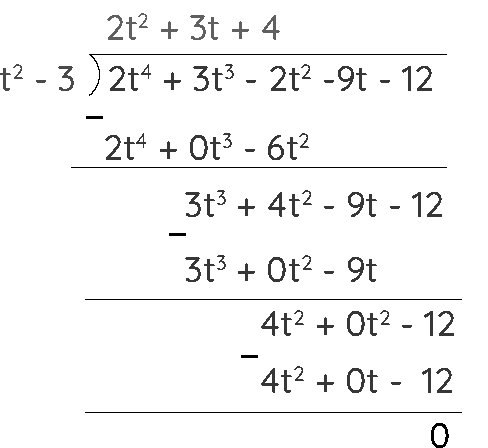
As we can see, the remainder is left as 0. Therefore, we say that, t2 – 3 is a factor of 2t4 + 3t3 – 2t2 – 9t – 12.
(ii) x2 + 3x + 1 , 3x4 + 5x3 – 7x2 + 2x + 2
First polynomial = x2 + 3x + 1
Second polynomial = 3x4 + 5x3 – 7x2 + 2x + 2
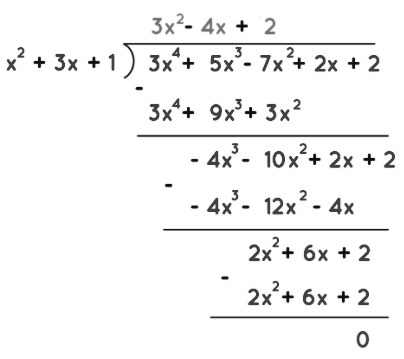
As we can see, the remainder is left as 0. Therefore, we say that, x2 + 3x + 1 is a factor of 3x4 + 5x3 – 7x2 + 2x + 2.
(iii) x3 – 3x + 1, x5 – 4x3 + x2 + 3x + 1
First polynomial = x3 – 3x + 1
Second polynomial = x5 – 4x3 + x2 + 3x + 1
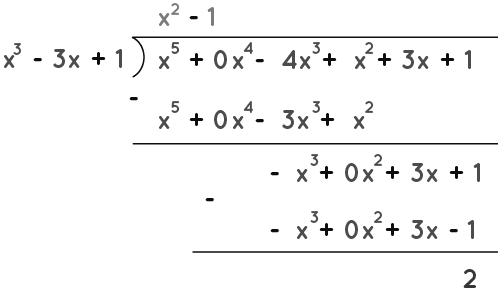
As we can see, the remainder is not equal to 0. Therefore, we say that, x3 – 3x + 1 is not a factor of x5 – 4x3 + x2 + 3x + 1 .
3. Obtain all other zeroes of 3x4 + 6x3 – 2x2 – 10x – 5, if two of its zeroes are and –
.
Solutions –
p (x) = 3x4 + 6x3 – 2x2 – 10x – 5
Since the two zeroes are and –
.
∴ =
is a factor of 3x4 + 6x3 – 2x2 – 10x – 5.
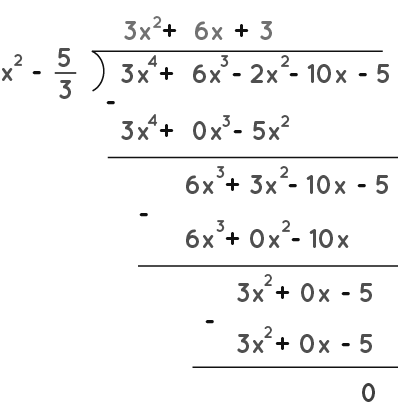
Therefore, 3x4 + 6x3 – 2x2 – 10x – 5 = (3x2 + 6x + 3) + 0
= 3 (x2 – ) (x2 + 2x + 1)
On factorizing x2 + 2x + 1, we get (x + 1)2
Therefore, its zero is given by
x + 1 = 0
x = – 1
As it has the term (x + 1)2,
Therefore, there will be two identical zeroes at x = – 1
Hence the zeroes of the given polynomial are and –
, – 1 and – 1.
4. On dividing x3-3x2+x+2 by a polynomial g(x), the quotient and remainder were x–2 and –2x+4, respectively. Find g(x).
Solution –
Dividend, p(x) = x3 – 3x2 + x + 2
Quotient = x – 2
Remainder = –2x + 4
We have to find the value of Divisor, g(x) =?
Dividend = Divisor × Quotient + Remainder
∴ x3 – 3x2 + x + 2 = g(x) × (x – 2) + (-2x + 4)
x3 – 3x2 + x + 2 – (-2x + 4) = g(x) × (x – 2)
Therefore, g(x) × (x – 2) = x3 – 3x2 + 3x – 2
Now, for finding g(x) we will divide x3 – 3x2 + 3x – 2 with (x – 2)
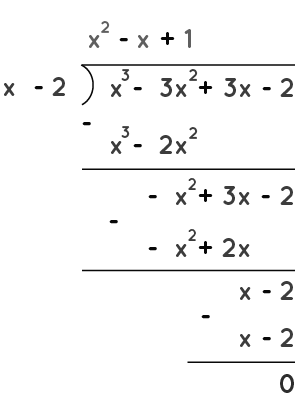
Therefore, g(x) = (x2 – x + 1)
5. Give examples of polynomials p(x), g(x), q(x) and r(x), which satisfy the division algorithm and
(i) deg p(x) = deg q(x)
(ii) deg q(x) = deg r(x)
(iii) deg r(x) = 0
Solutions – According to the division algorithm, dividend p(x) and divisor g(x) are two polynomials, where g(x)≠0. Then we can find the value of quotient q(x) and remainder r(x), with the help of below given formula;
Dividend = Divisor × Quotient + Remainder
∴ p(x) = g(x)×q(x)+r(x)
Where r(x) = 0 or degree of r(x)< degree of g(x).
Now let us proof the three given cases as per division algorithm by taking examples for each.
(i) deg p(x) = deg q(x)
Degree of dividend is equal to degree of quotient, only when the divisor is a constant term.
Let us take an example, p(x) = 3x2+3x+3 is a polynomial to be divided by g(x) = 3.
So, (3x2+3x+3)/3 = x2+x+1 = q(x)
Thus, you can see, the degree of quotient q(x) = 2, which also equal to the degree of dividend p(x).
Hence, division algorithm is satisfied here.
(ii) deg q(x) = deg r(x)
Let us take an example, p(x) = x2 + 3 is a polynomial to be divided by g(x) = x – 1.
So, x2 + 3 = (x – 1)×(x) + (x + 3)
Hence, quotient q(x) = x
Also, remainder r(x) = x + 3
Thus, you can see, the degree of quotient q(x) = 1, which is also equal to the degree of remainder r(x).
Hence, division algorithm is satisfied here.
(iii) deg r(x) = 0
The degree of remainder is 0 only when the remainder left after division algorithm is constant.
Let us take an example, p(x) = x2 + 1 is a polynomial to be divided by g(x) = x.
So, x2 + 1 = (x)×(x) + 1
Hence, quotient q(x) = x
And, remainder r(x) = 1
Clearly, the degree of remainder here is 0.
Hence, division algorithm is satisfied here.

Leave a Reply